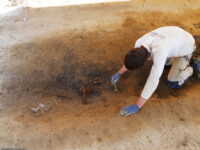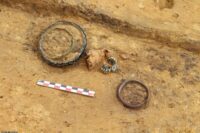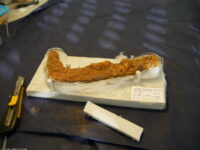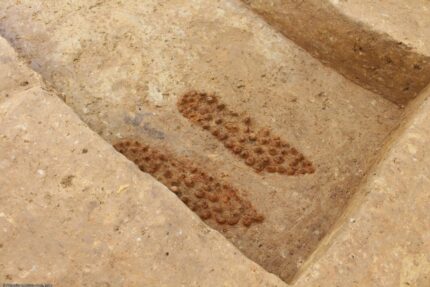 An excavation in the town of La Chapelle-des-Fougeretz near Rennes in Brittany, northwestern France, has uncovered a large Gallo-Roman sanctuary with numerous metallic votive deposits. A statuette of Mars indicates the sanctuary was dedicated to the god of war, and indeed many of the metal objects found at the site are elements of weapons and armour.
An excavation in the town of La Chapelle-des-Fougeretz near Rennes in Brittany, northwestern France, has uncovered a large Gallo-Roman sanctuary with numerous metallic votive deposits. A statuette of Mars indicates the sanctuary was dedicated to the god of war, and indeed many of the metal objects found at the site are elements of weapons and armour.
The sanctuary was built soon after the Roman conquest in the 1st century B.C. and was in continuous use until its abandonment in the 4th century A.D. In eight months of excavation, archaeologists unearthed a dozen iron swords, four billhooks, sickles and pieces of armature in the earthenware ditch of the sanctuary.
 The metal elements were removed from the ground as soon as they were found. All attached soil was cleaned off to prevent further damage from moisture. Most of the objects are heavily corroded making it difficult for archaeologists to identify them or determine breaks and damage. Radiographic and 3D computed tomography imaging gave researchers a look inside thick corrosion elements to the artifact or group of artifacts. The imaging technology also helps reveal the size, condition and placement of the metal within the corrosion materials, providing a roadmap for conservators to follow.
The metal elements were removed from the ground as soon as they were found. All attached soil was cleaned off to prevent further damage from moisture. Most of the objects are heavily corroded making it difficult for archaeologists to identify them or determine breaks and damage. Radiographic and 3D computed tomography imaging gave researchers a look inside thick corrosion elements to the artifact or group of artifacts. The imaging technology also helps reveal the size, condition and placement of the metal within the corrosion materials, providing a roadmap for conservators to follow.
 In addition to the sanctuary, the excavation of the site revealed a public bath facility, a few dwellings and a small necropolis of about 40 graves. The skeletal remains were basically gone, dissolved by the acidic soil, but grave goods and even the negative imprint of coffins remain. Funerary furnishings include delicate glass vessels, ceramic vases, the hobnails from shoes, bracelets, fibulae, belt buckles and glass beads. One particularly wealthy grave contained a set of harness fittings and a dagger. The contents of the graves date the necropolis to between the 4th and 5th century.
In addition to the sanctuary, the excavation of the site revealed a public bath facility, a few dwellings and a small necropolis of about 40 graves. The skeletal remains were basically gone, dissolved by the acidic soil, but grave goods and even the negative imprint of coffins remain. Funerary furnishings include delicate glass vessels, ceramic vases, the hobnails from shoes, bracelets, fibulae, belt buckles and glass beads. One particularly wealthy grave contained a set of harness fittings and a dagger. The contents of the graves date the necropolis to between the 4th and 5th century.
 The metal artifacts are undergoing stabilization and conservation. Ferrous elements must be soaked in alkaline baths for several months to stop corrosion before they can be safely handled and cleaned. In the interim, experts will analyze and date the objects that do not require special conservation, like pottery, to create a timeline for the phases of occupation at the site.
The metal artifacts are undergoing stabilization and conservation. Ferrous elements must be soaked in alkaline baths for several months to stop corrosion before they can be safely handled and cleaned. In the interim, experts will analyze and date the objects that do not require special conservation, like pottery, to create a timeline for the phases of occupation at the site.

Of course, NOBODY(!) knows about Alesia, and a *REAL golden sickle would never cut sprigs of mistletoe. However, as already by the 2nd century BC, the “R(i/h)EDONES” tribe had occupied the territory, according to Caesar (7.75):
——
“While those things are carried on at Alesia, the Gauls, having convened a council of their chief nobility, determine that all who could bear arms should not be called out, which was the opinion of Vercingetorix, but that a FIXED NUMBER should be levied from each state; […] They demand …
… six thousand from all the states that border on the Atlantic, and which in their dialect are called Armoricae (in which number are comprehended the Curisolites, RHEDONES, Ambibari, Caltes, Osismii, Lemovices, Veneti, and Unelli) …”
——
(*) Cf.: W. Spickermann, “Asterix und die Religion”, in: K. Brodersen (ed.), “Asterix und seine Zeit. Die große Welt des kleinen Galliers”, Munich 2008, ISBN 978-3-406-57347-7, pp. 105-126, here p. 115: “A sickle made of pure gold would […] be much too soft to actually cut mistletoe with. So one probably used GILDED sickles made of bronze or iron.”